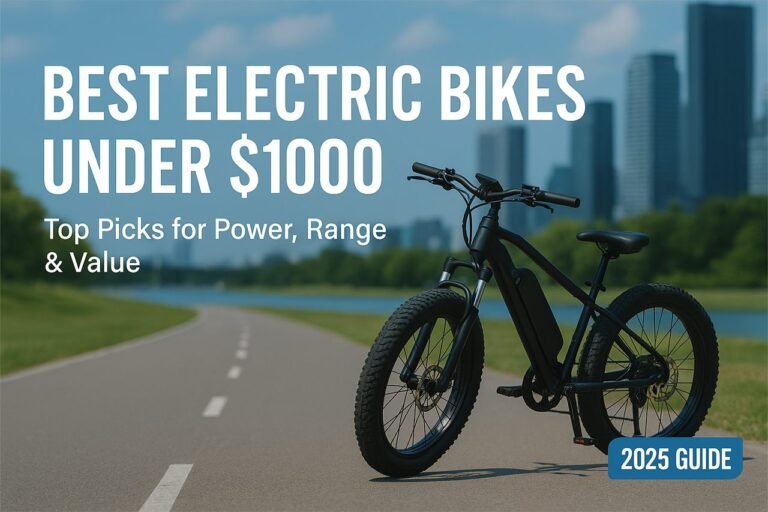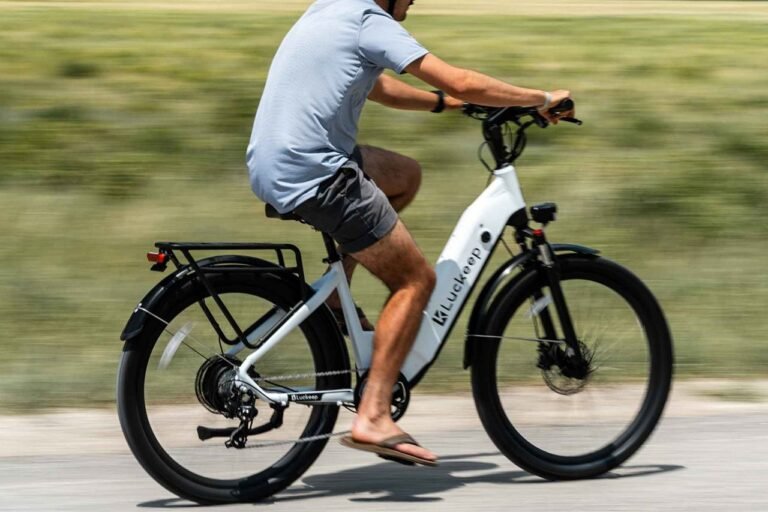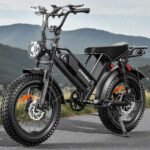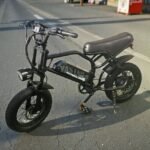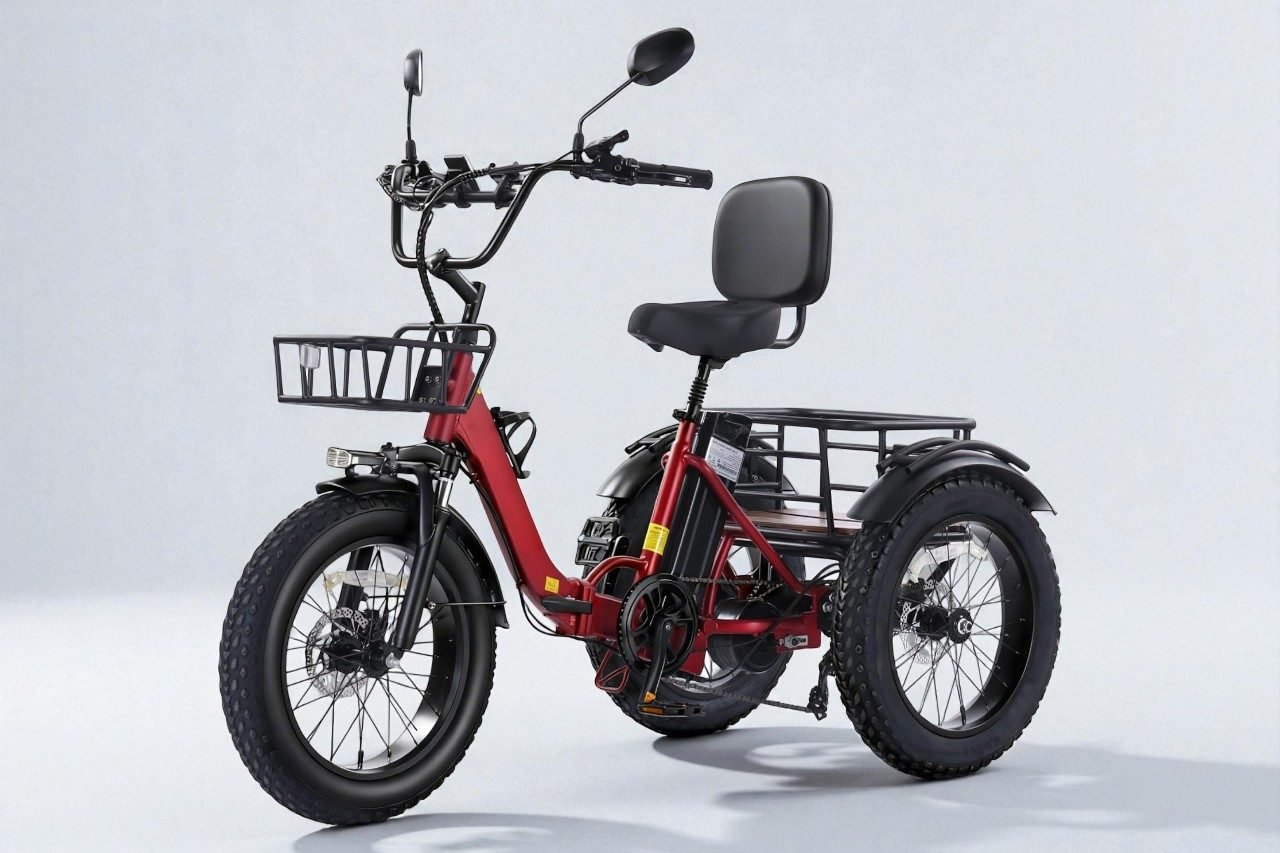

KAKIGO Electric Tricycle — Confident, Comfortable Cargo Rides
Our verdict: a powerful 3-wheel e-trike that blends stability, long range and huge storage for seniors, shoppers and everyday utility rides.
- 850W rear motor (1350W peak, 90 Nm) with rear differential for smooth, stable hill climbs and turns.
- UL-certified 48V 15.6Ah battery delivers up to 80–90 miles PAS range with IPX5 weather protection.
- Triple hydraulic disc brakes, fat 20″x4″ tires and huge front/rear baskets for up to 440 lb payload.
- Motor
- 850W hub (1350W peak)
- Battery
- 48V 15.6Ah UL-certified
- Top Speed
- 20 mph (Class 2)
- Range
- Up to 80–90 mi PAS
If you’ve ever wished your e-bike felt as stable as a small scooter – especially when carrying groceries, fishing gear, or just dealing with balance issues – the KAKIGO Electric Tricycle is exactly the kind of machine you have in mind. It combines a powerful rear hub motor, fat 20" x 4.0" tires, and a rear differential with a very low step-through, folding frame and huge baskets at both ends.
Instead of chasing high speeds or extreme off-road thrills, this trike focuses on control, comfort, and practicality. It’s built for riders who want to feel planted on three wheels, not anxious about tipping over at every stoplight or corner. Seniors, riders with limited mobility, or anyone who simply prefers a more secure riding experience are clearly the main audience here.
In this in-depth KAKIGO Electric Tricycle review, we’ll walk through its design, motor and battery performance, comfort, safety features, and everyday usability so you can decide if this 3-wheel fat-tire e-trike fits your lifestyle and budget.
Quick Verdict
The KAKIGO Electric Tricycle is a confidence-inspiring, cargo-ready e-trike aimed squarely at riders who value stability and comfort over outright speed. With an 850W rear hub motor (1350W peak), a UL-certified 48V 15.6Ah battery, fat 20" x 4.0" tires, and a rear differential, it climbs hills better than most utility trikes while remaining remarkably steady in corners and at low speeds.
It’s not light, and at around 20 mph top speed it won’t satisfy riders looking for a high-speed thrill machine. But for seniors, shoppers, campers, and anyone who wants a secure, sit-up-straight ride with serious cargo capacity (up to 440 lb combined), KAKIGO’s trike delivers a very compelling mix of power, range, and practicality for the price.
At a glance
- Category: Fat-tire, step-through, folding electric cargo tricycle for adults
- Motor: 850W rear hub (peak 1350W), ~90 Nm torque, rear differential
- Battery & Range: 48V 15.6Ah removable pack, UL-certified, up to 80–90 miles claimed in PAS; realistic 50–70 miles for most riders
- Top Speed: Up to 20 mph (factory-limited to ~15 mph for safety, adjustable via display)
- Bike Class: Class 2 (20 mph with pedal assist and throttle)
- Weight & Payload: Heavy 3-wheel chassis (around 100+ lb with battery), rated payload up to 440 lb
- Wheels & Tires: 20" x 4.0" fat tires on aluminum rims
- Brakes: Triple hydraulic disc brakes with parking brake function
- Drivetrain: Shimano 7-speed with thumb shifter + 5-level pedal assist
- Best For: Seniors, riders with balance concerns, cargo/utility use, relaxed rides on pavement, gravel, and light off-road paths
What Is the KAKIGO Electric Tricycle?
The KAKIGO Electric Tricycle is a 3-wheel, fat-tire electric bike designed to replace short-distance car trips, especially when you’re carrying cargo or just want absolute stability. With a low step-through aluminum frame and a wide, supportive seat with backrest, it feels more like a small electric scooter or mobility trike than a traditional bicycle.
Its defining features are the 20" x 4" fat tires, rear differential, and foldable step-through frame. Fat tires and front suspension keep the ride comfortable over broken pavement, gravel, and even some mild dirt or grass. The rear differential lets the two rear wheels turn at different speeds in corners, which makes turning smoother and reduces the risk of wheel scrub or tipping that you can experience on basic, “solid-axle” trikes.
KAKIGO positions this model as an all-round cargo trike for adults, with both front and rear baskets, integrated lighting, and a claimed rear cargo rating of up to 150 lb within the 440-lb overall payload. At roughly the mid-$1000s price point (often around $1,449), it sits in the mid-range segment of electric trikes – above ultra-budget models with smaller motors or basic mechanical brakes, but below the ultra-premium, multi-battery cargo trikes that cost twice as much.
Key Specs
| Spec | Detail |
|---|---|
| Bike Type | Fat-tire, step-through folding electric tricycle for adults |
| Motor | 850W rear hub motor, peak 1350W, ~90 Nm torque, rear differential |
| Battery | 48V 15.6Ah (approx. 748.8Wh), removable, UL-certified |
| Claimed Range | Up to 80–90 miles per charge in pedal-assist mode (lighter riders, low PAS) |
| Realistic Range | Roughly 50–70 miles PAS for an average adult on mixed terrain |
| Top Speed | Up to 20 mph; factory-limited around 15 mph for safety, adjustable via display |
| Bike Class | Class 2 (throttle + pedal assist to 20 mph) |
| Number of Speeds | 7-speed Shimano drivetrain with thumb shifter |
| Electric Assist Levels | 5 levels of pedal assist + throttle |
| Frame | Low step-through aluminum folding frame |
| Wheel & Tire Size | 20" x 4.0" all-terrain fat tires |
| Suspension | Front suspension fork with lockout + suspension seatpost under saddle |
| Brakes | Triple hydraulic disc brakes (front + both rear wheels) with parking brake function |
| Payload Capacity | Up to 440 lb total (rider + cargo); rear basket rated around 150 lb |
| Display & Controls | Backlit LCD display, integrated control pad, 5 PAS levels, walk mode |
| Accessories | Front & rear baskets, integrated lights, fenders, LCD display, phone holder, cup holder |
Who Is the KAKIGO Electric Tricycle Best For?
Ideal for
- Seniors and riders with balance concerns
Three wheels, a low step-through frame, and a wide seat with backrest make the KAKIGO an excellent option for riders who feel uneasy on a regular two-wheeled e-bike. You don’t have to swing a leg high over the frame or fight to keep the bike upright at stoplights. - Shoppers, campers, and cargo haulers
With big front and rear baskets and a rear rack rated up to about 150 lb of cargo, this trike is made for grocery runs, farmers’ markets, fishing trips, and weekend camping. It can easily carry a cooler, folding chairs, or a large backpack without feeling overloaded. - Short-to-medium daily commutes
If your commute is 5–15 miles round-trip across mostly urban or suburban streets, the KAKIGO’s range and 20 mph top speed are more than enough. You get plenty of acceleration from the 850W motor while still riding in a very upright, relaxed posture that’s great for visibility in traffic. - Mixed-surface leisure riding
The fat tires and front suspension fork are happy on grass, gravel park trails, and hard-packed dirt paths. You’re not buying this for single-track mountain biking, but as a leisure cruiser for parks, canal paths, or seaside boardwalks, it performs very well.
Not ideal for
- Riders who need a lightweight bike
This is a three-wheeled, fat-tire, cargo-capable machine. It is heavy. If you must regularly carry the trike up stairs or lift it into a tall vehicle by yourself, its weight will be a serious drawback. - Speed junkies
KAKIGO limits the top speed to about 15 mph out of the box for safety, and even after adjustment the trike sticks around 20 mph. This is deliberate: three-wheelers are more stable at moderate speeds than in fast, aggressive cornering. If you want a 28 mph Class 3 rocket, this isn’t it. - Very tight urban environments
The footprint is obviously wider than a standard bike. In cities with narrow bike lanes, very busy multi-use paths, or tight indoor storage spaces, you’ll need to pay attention to the rear width when threading through traffic or doorways.
Budget & value positioning
At roughly $1,449, the KAKIGO Electric Tricycle lands squarely in the mid-range of adult e-trikes. You’re paying more than bargain-bin trikes that use small 350–500W motors, mechanical disc brakes, and unbranded batteries, but in return you get:
- A strong 850W motor with 1350W peak output
- A UL-certified 48V 15.6Ah battery with decent real-world range
- Triple hydraulic disc brakes and a hydraulic parking brake
- Fat 20" x 4" tires and front suspension
- A rear differential for smooth turning
- A folding, step-through aluminum frame
Compared to premium cargo trikes that can easily reach $2,500–$4,000, KAKIGO offers a lot of real utility at a significantly lower price, making it an attractive option for value-focused buyers who still want quality components and a thoughtful design.
Design, Frame & Build Quality
Visually, the KAKIGO Electric Tricycle stands out immediately with its black frame, contrasting brown fat tires, and matching tan saddle and backrest. It has a utilitarian but stylish look that feels more like a modern urban mobility device than an old-fashioned upright trike.
The frame is a step-through aluminum design with a surprisingly low standover height. That’s crucial for seniors or anyone with limited hip flexibility, because you can step in from the side rather than swinging a leg high over the rear rack. The frame also folds at the center, allowing you to reduce its footprint for storage or occasional transport in a truck bed or large SUV.
Welds and paintwork are generally neat and tidy for this price bracket. Cables are routed cleanly along the frame with protective wrap where needed. Because this is a trike, some externally routed cables around the rear differential and twin brake calipers are unavoidable, but they’re secured well enough that you’re not constantly snagging them when loading cargo.
The front and rear baskets are solidly built with thick tubing and a supportive base. The rear basket is especially impressive: it’s wide and deep enough for a large grocery haul or a cooler and camping gear, and the frame design supports the weight without obvious flex. KAKIGO lists an overall payload rating of up to 440 lb, and while you should always be conservative with real-world loads, the structure feels robust enough for serious utility use.
Fenders, headlight mount, and integrated accessories like the phone holder and cup holder are more than simple afterthoughts. They add to the sense that this trike is designed for real daily use, not just the occasional weekend ride.
Motor Performance & Speed
The heart of the KAKIGO Electric Tricycle is its 850W rear hub motor, which can deliver up to 1350W peak power and around 90 Nm of torque. On a heavy, cargo-capable trike, that extra headroom matters.
Acceleration & cruising
Out of the box, the trike is configured conservatively. The factory top speed is capped around 15 mph, and the pedal-assist levels ramp up smoothly rather than surging aggressively. This makes a lot of sense for the intended riders: seniors and people new to e-bikes often prefer predictable, gentle acceleration over snap-your-neck launches.
Using higher PAS levels or full throttle, the KAKIGO has no problem getting up to its 20 mph max on flat ground. The 850W motor pulls confidently even when you’re carrying a full rear basket of groceries. You’ll feel the weight, but you won’t feel like the trike is struggling.
Hill-climb performance
On moderate hills, the KAKIGO performs very well for a trike in this class. With a reasonably fit adult in PAS 3–4, you can expect to climb typical suburban grades (6–8%) at 10–15 mph without needing to stand or mash the pedals. Using throttle alone, steep hills will slow you down, but the motor keeps chugging along without sounding strained.
The rear differential helps enormously with stability when climbing and cornering on an incline. On a simple solid-axle trike, one rear wheel can lose grip or skip sideways under torque in tighter turns. Here, the differential allows each wheel to spin appropriately, so the trike feels more composed, especially on uneven surfaces or when you’re crossing driveways at an angle.
Noise & refinement
KAKIGO emphasizes “optimized noise reduction,” and while this is still a hub motor you can hear, it’s far from obnoxious. The motor emits the usual electric whirr, but wind and tire noise quickly become more dominant once you’re above about 12 mph.
Overall, the power delivery is predictable and confidence-inspiring. It’s tuned more for steady, controllable push than for explosive acceleration – exactly what most trike buyers actually need.
Battery, Range & Charging
The trike uses a 48V 15.6Ah removable lithium battery (around 748.8Wh). It’s UL2272-certified, and KAKIGO also highlights compliance with UL2849 e-bike system safety standards. That’s an important reassurance for riders who worry about battery safety and charging indoors.
The battery is mounted centrally within the frame, helping keep the center of gravity low. A keyed lock secures it, and there’s a convenient handle for removing and carrying the pack. You can charge it either on the trike or off it – useful for apartment dwellers who store the trike in a garage but want to bring the battery inside.
Claimed vs realistic range
KAKIGO advertises up to 80–90 miles per charge in optimal pedal-assist conditions. As always, real-world range depends on rider weight, terrain, cargo load, temperature, and PAS level. For an average-weight adult (around 170–190 lb) using PAS 2–3 on mostly flat terrain with light cargo, it’s reasonable to expect:
- 50–70 miles of range in mixed PAS riding
- 35–45 miles with frequent throttle use, hills, or heavy cargo
This is still very solid for a mid-range 48V system and should comfortably cover several days of normal errands or commuting before you need to recharge.
Charging
Expect a 6–8 hour charge time from nearly empty to full using the included charger. Many riders simply plug in overnight and start each day with a full battery. The battery management system (BMS) includes over-charge, over-discharge, short-circuit, and temperature protection, so normal overnight charging is safe when done with the original charger on a non-flammable surface.
The pack and its housing carry an IPX5 waterproof rating, so rain and splashes are not a problem. You still shouldn’t submerge the trike or leave the charger exposed to water, but riding in bad weather or through puddles is within its design envelope.
Ride Comfort & Handling
Comfort and confidence are where the KAKIGO Electric Tricycle really shines.
Comfort
The riding posture is very upright and relaxed. The handlebar rises toward you with a slight sweep, so you don’t have to lean forward aggressively. Combined with the wide, cushioned saddle and matching backrest, this creates a riding position closer to a small scooter than a typical bicycle.
The seat is highly adjustable:
- Seat height can be raised or lowered for different leg lengths.
- Fore-aft position allows you to move closer to or further from the handlebar.
- Backrest height can be fine-tuned so it supports your lower back rather than digging into your spine.
Under the seat, a suspension seatpost works with the front suspension fork and fat tires to soak up road chatter. At reasonable pressures, the 20" x 4" tires add a cushy, balloon-like feel. Combined, these elements do a good job of smoothing out potholes, brick paths, and cracked pavement.
For long rides, this matters. Instead of your lower back and wrists taking a beating, the forces are spread out between the suspension, fat tires, and broad contact surfaces of the saddle and backrest. Riders with joint issues or previous injuries are likely to appreciate this setup.
Handling & stability
Handling on a three-wheeler is different from a two-wheeled bike, and that’s worth emphasizing. You don’t lean into corners in the same way; the trike stays more upright while your body shifts weight slightly. With its low center of gravity, wide rear track, and rear differential, the KAKIGO feels notably more stable than low-end trikes that can feel twitchy or top-heavy.
At low speeds – parking lots, crowded paths, tight turns – the trike is extremely forgiving. You can crawl along at walking pace without worrying about balancing. Starting from a stop is easy: just sit, press the pedals lightly, and let the motor take you up to speed.
At higher speeds (15–20 mph), especially in downhill turns, common-sense caution is still essential. Any trike can tip if you dive hard into a corner at speed. Keeping your weight to the inside of the turn, taking corners smoothly, and respecting the trike’s limits will keep the ride safe and enjoyable.
The fat tires provide tons of grip and a planted feel on gravel and grass. Soft surfaces that might feel sketchy on skinny tires are no problem here – and the extra footprint helps when you’re riding with a full rear basket.
Brakes & Safety Features
For a heavy, cargo-capable trike, brakes are not the place to cut corners. KAKIGO equips this model with triple hydraulic disc brakes: one on the front wheel and one on each rear wheel. That’s a big step up from the mechanical brakes found on many lower-priced trikes.
Brake levers offer a light, smooth pull with a clear bite point. Modulation is easy, so you can feather the brakes gently when creeping down ramps or apply more force for emergency stops. With the weight of the trike and rider, you don’t get motorcycle-like stopping distances, but braking feels confident and predictable.
A standout detail is the hydraulic parking brake function. When you’re loading heavy cargo or parking on a mild slope, you can lock the brakes to keep the trike from rolling away. This sounds minor until you’ve tried holding a loaded trike still with only one hand on the brakes while wrestling bags with the other.
Other safety-related features include:
- High-visibility lighting – A bright front headlight helps you see and be seen; many builds also include a rear light or reflectors for visibility from behind.
- Reflective sidewalls and fat-tire footprint – Bigger tires mean a larger contact patch for improved grip, especially on loose or wet surfaces.
- UL-certified battery and electronics – UL2272/UL2849 certifications add an extra layer of reassurance about electrical safety.
- IPX5 water resistance – The system is designed to handle rain, splashes, and puddles without issue.
Altogether, these elements make the KAKIGO feel like a well-thought-out package for older or more cautious riders who place a premium on safety.
Controls, Display & Riding Modes
The cockpit of the KAKIGO Electric Tricycle is busy but user-friendly.
Front and center sits a backlit LCD display showing:
- Current speed
- Assist level
- Battery level
- Trip and total mileage
- Other system indicators
To one side of the handlebar, an integrated control pad lets you toggle power, change PAS levels, and access walk mode without taking your hands far from the grips. The layout is intuitive: after a ride or two, most riders will adjust assist levels by feel alone.
Pedal-assist behavior
The trike uses 5 levels of pedal assist, paired with what KAKIGO describes as a torque sensor. This means the system responds not just to whether you’re pedaling but also to how hard you’re pushing, offering a more natural, “bike-like” feel than simple cadence-only systems.
- PAS 1–2 provide gentle support, ideal for flat neighborhoods, bike paths, and riders who want light exercise.
- PAS 3–4 are your everyday workhorses, giving a strong push for moderate hills and heavier cargo.
- PAS 5 delivers maximum assistance and is best saved for steep climbs or when you’re in a hurry.
The power ramp between levels is noticeable but not jumpy, so you don’t get that “on/off rocket” feeling when you accidentally bump the assist up a notch.
Throttle & walk mode
A thumb or twist throttle (depending on spec) lets you ride without pedaling when needed. This is particularly handy for:
- Starting off from a stop with heavy cargo
- Short stretches when your knees need a break
- Maneuvering in parking lots or loading zones
Walk mode provides a low-speed push so you can guide the trike while walking alongside it – useful in crowded areas or when pushing up a ramp.
Extra touches
The included phone holder and cup holder are surprisingly practical. For riders who use navigation on their smartphone, having the screen mounted securely and within view is far more convenient than pulling the phone from a pocket. The cup holder is perfect for a water bottle or takeaway coffee on shorter errands.
Fit, Sizing & Adjustability
KAKIGO designs this trike to fit a broad range of adult riders. While exact numbers may vary, it’s generally suitable for heights around 5'2" to 6'2".
The low step-through makes mounting and dismounting easy even for shorter riders or those with limited mobility. From there, you have several adjustment points:
- Seat height – Extends high enough for taller riders while lowering sufficiently for shorter ones to keep a comfortable bend in the knee.
- Seat fore-aft & backrest – Let you fine-tune distance to the bars and lower-back support.
- Handlebar angle – Can usually be rotated slightly to bring the grips closer or further away.
Because of its upright posture and backrest, riders who are used to sporty bikes may need an adjustment period. But for most casual riders, the “armchair on wheels” feeling quickly becomes a favorite.
Very small riders (under ~5'2") or very tall riders (above ~6'3") may find it harder to achieve a perfect fit, especially in terms of leg extension. If you’re at either extreme, measuring your inseam and comparing it with the published saddle height range is a smart step before purchase.
Assembly & Out-of-the-Box Experience
KAKIGO ships the electric trike about 90% pre-assembled. For many buyers, especially seniors, the thought of assembling a three-wheeled e-bike can be intimidating, so this is an important part of the experience.
The trike arrives well-protected in a reinforced box, with foam and cardboard bracing around the frame and wheels. Inside, you’ll find:
- The main frame with rear wheels and drivetrain already installed
- Front wheel and fork assembly
- Handlebars, pedals, front basket, and small accessories separately protected
Assembly typically involves:
- Mounting and securing the handlebar.
- Installing the front wheel and front fender.
- Attaching the front basket.
- Screwing on the pedals (remember: left pedal has a reverse thread).
- Installing the seat and backrest.
- Adjusting brakes and gears if needed.
For most people with basic mechanical skills, expect 60–90 minutes of unboxing and assembly. KAKIGO supports the process with tools, a printed manual, and step-by-step video guides, which are particularly helpful for visual learners.
If you’re not comfortable turning wrenches, it’s perfectly reasonable to ask a local bike shop or mechanically inclined friend to handle final assembly and safety checks. Given the trike’s weight and speed, having the brakes and gears dialed in correctly is worth the small extra cost.
What’s Included in the Box?
In the box:
- KAKIGO Electric Tricycle (frame with rear wheels and drivetrain largely pre-assembled)
- 48V 15.6Ah removable battery
- Battery charger
- Front wheel and tire
- Front and rear baskets
- Wide saddle with backrest and suspension seatpost
- Front and rear fenders
- Integrated front light (and rear light/reflectors depending on configuration)
- Phone holder and cup holder
- Basic multitool and assembly hardware
- User manual and warranty information
Our take on the package
Overall, the included accessories are generous. You don’t need to immediately buy racks, baskets, or lights – the trike arrives ready for real grocery-run and errand duty. The phone holder and cup holder are thoughtful touches that many brands leave for aftermarket purchases. The only things some riders might add are a rear-view mirror upgrade, heavier-duty lock, or a more powerful headlight if you ride frequently at night.
Pros & Cons
| Pros | Cons |
|---|---|
| Very stable 3-wheel platform with rear differential | Heavy and bulky; not easy to lift or carry |
| Powerful 850W motor (1350W peak) with strong hill capability | Limited to ~20 mph; not for riders seeking high speed |
| UL-certified 48V 15.6Ah battery with solid real-world range | Wider rear track can be awkward in narrow bike lanes |
| Triple hydraulic disc brakes plus parking brake | Assembly is more involved than a simple two-wheel e-bike |
| Comfortable wide saddle with adjustable backrest and suspension | Turning technique takes adjustment if you’re used to regular bikes |
| Front and rear baskets with high payload (up to 440 lb total) | LCD display is functional but not fancy or color |
| Fat 20" x 4" tires and front suspension for all-terrain comfort |
How the KAKIGO Electric Tricycle Compares to Alternatives
When shopping for an electric trike, you’ll likely compare KAKIGO with a few key competitors. Here’s how it generally stacks up conceptually against common alternatives in this category.
- Versus basic budget e-trikes (350–500W, mechanical brakes)
Compared to the most affordable adult e-trikes, the KAKIGO offers a noticeably stronger motor, larger battery, hydraulic brakes, and better overall build quality. It feels more planted and capable, especially on hills and with heavy cargo. You pay more upfront, but you avoid many of the compromises (weak braking, limited range, under-powered motors) that plague the cheapest options. - Versus other mid-range fat-tire trikes
Many mid-range e-trikes offer fat tires and larger batteries, but not all include a rear differential or triple hydraulic brakes. The differential is a genuine upgrade for stability and cornering, and the UL certifications are a nice extra compared with some similarly priced competitors. - Versus premium cargo e-trikes and utility bikes
High-end cargo bikes and trikes can come with mid-drive motors, dual batteries, and premium components – and price tags two to three times higher. Those bikes are excellent for families replacing a car or carrying children daily. KAKIGO, by contrast, is focused on single-rider comfort and cargo practicality. It gives you much of the utility without requiring such a large investment.
In short, KAKIGO’s e-trike hits a sweet spot for riders who want more capability and safety than bargain options provide, but who don’t need a full-blown, ultra-premium cargo hauler.
Common Questions About the KAKIGO Electric Tricycle
Q: Is the KAKIGO Electric Tricycle legal to ride where I live?
A: The trike is configured as a Class 2 e-bike in most U.S. markets, with pedal assist and throttle support up to 20 mph. Many states and cities treat Class 2 e-bikes similarly to conventional bicycles on streets and bike paths, but regulations vary. It’s always wise to check your local rules, especially regarding e-bikes on shared trails or in national/state parks.
Q: How far can it really go on a single charge?
A: Under ideal conditions (lighter rider, flat terrain, PAS 1–2), KAKIGO cites up to 80–90 miles per charge. In more typical mixed riding with an average adult and some hills, expect 50–70 miles in pedal-assist mode. Heavy cargo, frequent full-throttle use, strong headwinds, or very hilly terrain will reduce that figure.
Q: Can I ride the KAKIGO trike in the rain?
A: Yes, within reason. The electrical system and battery carry an IPX5 rating, meaning they can handle rain and splashes but shouldn’t be submerged. Riding in wet conditions is fine, but you should dry the trike afterward, avoid high-pressure hose sprays on electrical parts, and store it under cover when possible to maximize longevity.
Q: Is it suitable for heavier riders?
A: The trike is rated for up to 440 lb of total payload, including rider and cargo. Combined with the strong 850W motor and durable frame, this makes it a good option for heavier riders who may feel unstable on a regular two-wheel e-bike. As always, staying within the manufacturer’s stated limits and keeping tires properly inflated will help maintain safe handling.
Q: How hard is it to learn to ride a three-wheel e-trike?
A: If you’re comfortable with basic bike controls (steering, braking, pedaling), you’ll adapt quickly. The main difference is in corners: rather than leaning the bike, the trike stays upright while you shift your weight slightly into the turn and take corners at reasonable speeds. Most riders feel confident after a few short practice rides in a quiet parking lot.
Q: Can I transport the KAKIGO trike in my vehicle?
A: The folding frame helps reduce the overall length for storage and transport, but this is still a large, heavy machine. For most people, it’s best transported in the back of a pickup truck, small trailer, or large cargo van rather than on a standard bike rack. If you plan to move it frequently by car, measuring your vehicle’s dimensions and considering ramps is recommended.
Final Verdict – Should You Buy the KAKIGO Electric Tricycle?
Score: 9.0 / 10
The KAKIGO Electric Tricycle is a thoughtfully designed, comfort-focused e-trike that delivers on its promises: strong and controlled power, excellent stability, generous cargo capacity, and an easy-to-ride platform that inspires confidence rather than anxiety. It’s particularly well-suited to seniors, riders with balance challenges, and anyone who wants a practical alternative to short car trips for shopping, errands, and leisure rides.
Its main compromises – substantial weight, modest top speed, and a wider footprint – are inherent to the category. If you want a nimble, lightweight city bike you can carry upstairs or a 28 mph speed machine, this isn’t the right e-bike. But if you prioritize safety, comfort, and real-world utility, those trade-offs are entirely reasonable.
In the crowded e-trike market, KAKIGO’s combination of an 850W motor, UL-certified 48V 15.6Ah battery, hydraulic brakes, rear differential, and well-equipped cargo setup makes it stand out as one of the more compelling options in its price range.
If you’re looking for a stable, comfortable, and cargo-ready electric tricycle to handle shopping runs, countryside rides, and everyday errands with ease, the KAKIGO Electric Tricycle absolutely deserves a spot at the top of your shortlist. To check current pricing and any available color options, search for the KAKIGO Electric Tricycle for Adults on Amazon or your preferred retailer.
| Preview | Product | Price | |
|---|---|---|---|
|
|
KAKIGO Electric Tricycle for Adults,Peak 1350W Motor Etrike,48V15.6Ah Ebike,20"x4"Fat Tire Aluminum... | $1,389.00 | View on Amazon |


![Real Riders, Real Reviews: Discover the Best Velowave Electric Bikes of [year] VELOWAVE Electric Bike Reviews](https://goebikelife.com/wp-content/uploads/2024/09/VELOWAVE-Electric-Bike-Reviews-768x512.jpg)
